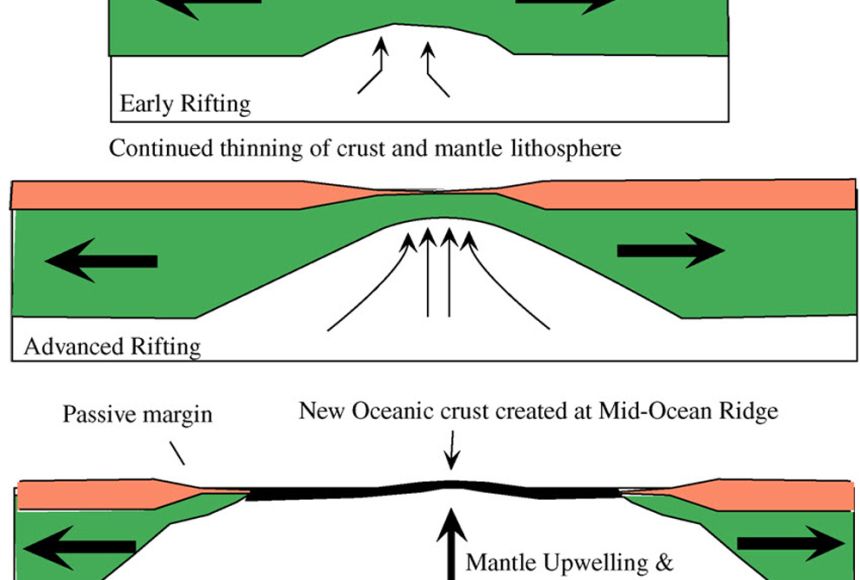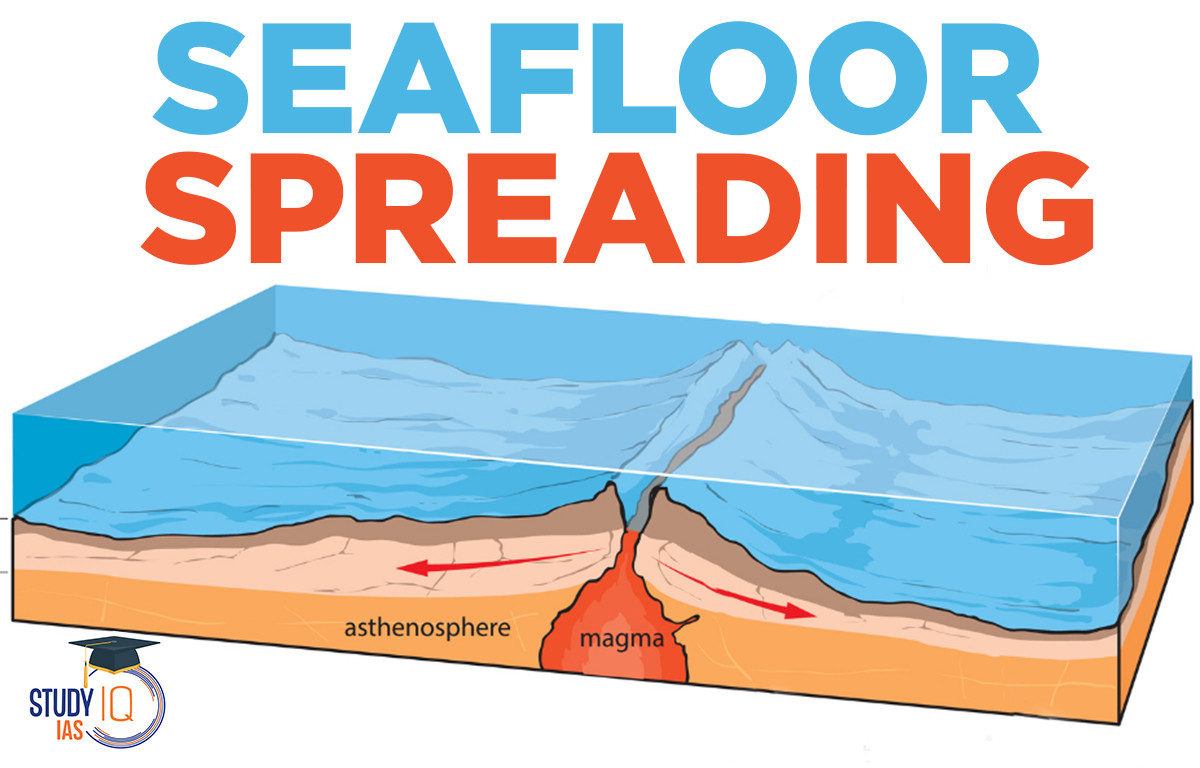Table of Contents
Post-drift studies, like ocean floor mapping, showed that oceanic rocks are much younger than continental rocks. Rocks near mid-ocean ridges were similar in composition and age. In the 1930s, Arthur Holmes contributed to this with his convection current theory, suggesting that convection currents in the Earth’s mantle, caused by heat from radioactive elements, are important. These discoveries helped lead to the development of the seafloor spreading theory.
Seafloor Spreading
Seafloor Spreading Theory was put forth by American geophysicist Harry H. Hess in 1960. Seafloor spreading happens when volcanic eruptions at mid-ocean ridges cause the oceanic crust to crack. New lava fills these cracks, pushing the crust apart on either side. At subduction zones, oceanic crust sinks beneath continents or other oceanic plates and returns to the mantle.
An example of seafloor spreading is the East Pacific Rise, located in the Ring of Fire, where the Pacific Plate meets the Cocos, Nazca, North American, and Antarctic Plates.
Seafloor Spreading Diagram
Here is the elaborated diagram of Seafloor Spreading:

Sea Floor Spreading Theory
At mid-ocean ridges, where new oceanic crust is created by volcanic activity and gradually moves away from the ridge, the seafloor spreading process takes place. Harry Hess proposed the idea that the continents move when the seafloor shifts as it spreads out from a central axis.
Seafloor Spreading Theory states that the intense heat produced by radioactive substances in the mantle, which is located between 100 and 2900 kilometres beneath the surface of the planet, searches for a route out and induces convection currents to form. On the ocean floor, oceanic ridges and trenches form where the rising and descending limbs of these currents meet. New material is introduced to the ocean floor as older material is pushed away from the crest.
As molten material erupts from the mantle, spreads out, and pushes older materials to the sides of the rift, a new ocean floor forms along fractures in the ocean crust. The additional ocean floor is being added as a result of sea-floor spreading.
Seafloor Spreading Theory Evidence
1. Evidence from Magma
Evidence shows that molten material burst out of cracks along the mid-ocean ridge and quickly cooled, creating rock pillows.
2. Evidence from Drilling Samples
Ocean floor core samples show that the youngest rocks are found in the centre of the ridge, whereas older rocks are found further from the ridge.
3. Evidence from Magnetic Stripes
The ocean floor rocks have a pattern of magnetic stripes that record changes in the Earth’s magnetic field.
4. Subduction
When a section of the ocean floor descends into a deep ocean trench, it then descends back into the mantle.
5. Deep Ocean Trench
This happens in subduction zones at the Deep Ocean Trench. Here, deep underwater canyons form as the ocean crust bends downwards.
Seafloor Spreading Effects
- Seafloor spreading impacts the carbon cycle and sea level.
- The ridge expands as the seafloor spreads more quickly.
- Hot, young lithosphere forms and moves away from the ridge before cooling and shrinking., This process causes sea level to rise.
- Faster spreading leads to increased volcanic activity.
- Volcanic activity releases greenhouse gases, affecting the carbon cycle.
Significance of Seafloor Spreading Theory
- Foundation of Plate Tectonics:
- Role: The Seafloor Spreading Theory is a key component of the broader Plate Tectonics Theory, providing a mechanism for the movement of Earth’s lithospheric plates.
- Impact: It helps explain the dynamic nature of Earth’s surface and the formation of various geological features.
- Understanding Oceanic Crust Formation:
- Role: The theory elucidates how new oceanic crust is created at mid-ocean ridges and how it moves away from these ridges.
- Impact: This understanding helps in studying the growth and evolution of ocean basins.
- Explanation of Magnetic Striping:
- Role: It accounts for the symmetrical patterns of magnetic stripes on the ocean floor, which are created by periodic geomagnetic reversals.
- Impact: These patterns provide evidence for the ongoing process of seafloor spreading.
- Insight into Geological Activity:
- Role: The theory helps explain the occurrence of volcanic activity and earthquakes at mid-ocean ridges and oceanic trenches.
- Impact: It contributes to the understanding of volcanic and seismic activity patterns.
- Support for Continental Drift:
- Role: Seafloor spreading provides a mechanism for the movement of continents, supporting the earlier theory of continental drift proposed by Alfred Wegener.
- Impact: It helps reconcile and integrate various geological observations related to continental movement.
- Impact on Geologic Mapping:
- Role: The theory aids in predicting the location and distribution of geological resources and hazards.
- Impact: It informs geological surveys and resource management, including the exploration of oil and minerals.
- Advancements in Geophysical Techniques:
- Role: The theory has driven the development of new geophysical methods to study the ocean floor and tectonic processes.
- Impact: It has led to improved technologies for mapping and monitoring Earth’s geology.
Seafloor Spreading Reasons Behind Decline
1. Growing Mountains on the Continents
One reason for the slowdown in seafloor spreading might be the rising mountain ranges on continents, which create resistance. When the supercontinent Pangea began breaking apart around 200 million years ago, there were no major plate collisions or mountain ranges, and the continents were mostly flat. Changes in mantle convection could also play a role. Mantle convection is how heat moves from the hot core to the cooler crust above. Over time, the mantle cools slowly due to heating and cooling from below and above.
2. Mature Stage of the Supercontinent Breakup
As Pangea slowly broke apart, new ocean basins formed, and the separated continents began to collide with each other. For example, this happened between Africa and Eurasia, the Arabian Peninsula and Eurasia, and India. These collisions are a normal result of the supercontinent breaking down and reaching a more advanced stage.
Seafloor Spreading Theory Limitations
- Incomplete Mantle Dynamics: The theory doesn’t fully explain the complex convection processes in the Earth’s mantle.
- Variable Spreading Rates: It doesn’t consider the different spreading rates at various mid-ocean ridges.
- Limited Continental Crust Explanation: The focus is mainly on oceanic crust, not on how continental crust forms and behaves.
- Complex Plate Interactions: It oversimplifies interactions at plate boundaries and doesn’t cover all types, like transform faults.
- Subduction Processes: The theory doesn’t explain how subduction works or how old oceanic crust is recycled.
- Measurement Challenges: Measuring crustal movement and spreading rates accurately is difficult and often imprecise.
- Evolving Theory: Seafloor spreading is part of the larger Plate Tectonics Theory, which includes more mechanisms and processes.
Seafloor Spreading UPSC
The Seafloor Spreading Theory is fundamental in understanding Earth’s geology and plate tectonics. The evidence from magnetic striping, the age of oceanic crust, fossil distribution, and ocean floor topography collectively supports this theory, which continues to shape our knowledge of Earth’s dynamic processes.


 Role of Teachers in Educations, Student ...
Role of Teachers in Educations, Student ...
 India's achievements after 75 years of I...
India's achievements after 75 years of I...
 Bal Gangadhar Tilak Biography, Achieveme...
Bal Gangadhar Tilak Biography, Achieveme...

























